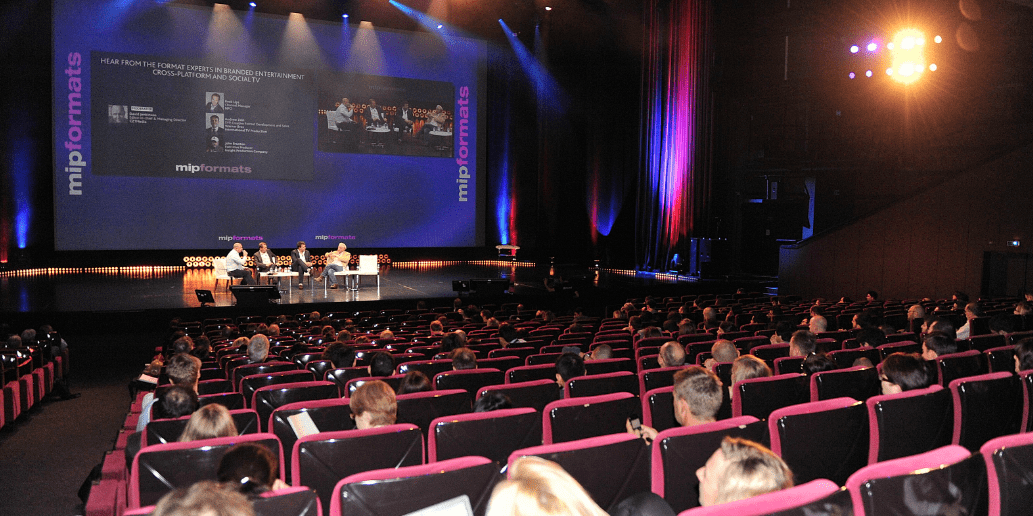This afternoon at MIPFormats saw a series of sessions session focused on branded entertainment and the opportunities offered by digital platforms and social media; with a focus on how these new players can work with the formats industry.
One panel (photo) saw NPO channel manager Roek Lips make a decidedly apt comment: “Understanding the new media behaviour of people is the biggest thing we have to do at the moment… You have to find the right way of doing it, but I think it will make television much bigger again.”
Yet it was the following panel that glimpsed the furthest into the future, with Doug Scott, president of Ogilvy Entertainment; Mike Morley, chief creative officer and EVP of Sony Pictures Television; Simon Brickle, director of Monterosa Productions; and Danny Fenton, CEO and executive chairman of Zig Zag. C21Media editor-in-chief David Jenkinson moderated.
“We’ve taken somewhat of a methodical approach to developing (branded) content for our clients,” said Scott. “It really starts with the planning process, just like any campaign would.”
Ogilvy wanted to elevate brands culturally, according to Scott. “We’re one of the few agencies out there that are looking at branded entertainment as something that is bespoke, and something that is a collaborative process.”
He admitted that the economics of the business are a challenge, as is platform fragmentation, due to the plethora of new devices for audiences to use to watch TV and access other forms of entertainment.
Scott is also seeing plenty of hybrid deals for brands, with a mixture of funding content, other kinds of sponsorship, and ‘activation’ to bring that content into the retail space.
Sony Pictures’ Morley said that “we’re going through a period that could probably be classified as a commercial and social revolution“, suggesting that now is the time for brands to “step out of the 30-second slot… it’s now or never”.
Is this changing Sony Pictures’ content development? Morley ran a showreel of some of the company’s new formats, including Cover Me, Impossible and The Substitute. Morley explained that Sony looked for specific gaps in the schedules that could be filled by new shows – “we looked for gaps, and we looked also for demographics”.
Monterosa’s Simon Brickle was up next. It’s a producer of ‘two-screen entertainment’ working with TV companies and broadcasters, developing its own formats and working on other people’s.
One example is UK broadcaster’s ITV Live website, which lets football fans follow matches and chat to others. Another is Endemol’s Million Pound Drop, a game show where viewers can answer questions online as they are asked in the show.
“The thing that’s really become clear, particularly with Million Pound Drop, is how much there is to gain from working with the TV production firm from the very beginning,” he said. “The TV part makes room for the online element and drives people onto playing along, and then creating valuable content that is fed back into the show. That’s the virtuous circle.”
Nearly 10% of the TV audience for the show has been playing along, he says. Monterosa is currently working on a fashion show, in partnership with agency Mother and retailer New Look, which will be one of the first product placement shows on British TV. Brickle talked about the dealmaking opportunities that are available.
“Some of the most interesting deals that we’re doing now are people who want to create an idea with us from the ground up,” he said. “It’s easier to do a deal that involves shared IP and shared revenues… It’s a bit harder if somebody’s already got an idea and a broadcaster is interested. It becomes a bit of a different deal.”
Zig Zag’s Fenton spoke last about how his company approaches creating formats. “Television is more of an art, but the more of a theory you can apply to it, the better chance you have of having a hit.”
He also talked about the pros and cons of being part of a larger group – production company Zig Zag recently bought itself back from Banijay, becoming independent again after having been acquired in January 2010.
He talked about a pressure on creativity within larger companies, given the current economic climate. “In the last six months since we’ve bought ourselves back, I’ve noticed the creative flip – we’ve come up with better ideas,” he said.
“Our mission statement is to be noisy and attention-grabbing. In a very crowded market, how do you shout louder than other people?” he said, citing the example of reality game-show Relentless, which was created as a way to take the genre “out of the studio”.
“As producers, we have to push the creative boundaries. Whatever it takes to push those boundaries, that’s where the rewards will come.”
Where do apps fit in to these formats? “I think you’ll see people working with apps very very shortly,” said Morley. “We have two to three different programmes developed from the app forwards, rather than taking the programme and developing an app for it. When you look at the incredible uptake because of the platform distribution – it all goes to Apple or goes out from Apple – you realise there is a new business model there.”
Fenton said Zig Zag is also working on apps, although it chooses the shows that are appropriate. Meanwhile, Scott said that the screen-shift that has taken place is important, as people are carrying screens around with them.
“Apps today are more important than they’ve ever been – digital across the board – to define a format against the marketplace,” he said. “It’s where that extension is beyond the linear appointment-based programme that’s out there.”




